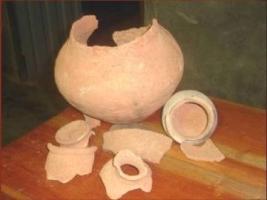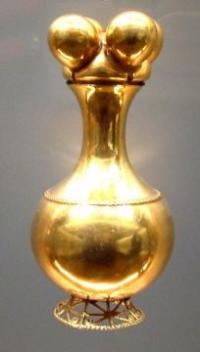Copy Link
Add to Bookmark
Report
HOMEBREW Digest #2392

HOMEBREW Digest #2392 Tue 08 April 1997
FORUM ON BEER, HOMEBREWING, AND RELATED ISSUES
Digest Janitor: janitor@brew.oeonline.com
Many thanks to the Observer & Eccentric Newspapers of
Livonia, Michigan for sponsoring the Homebrew Digest.
URL: http://www.oeonline.com
Contents:
Pressure decoction - further thoughts (Charles Rich)
Hop Profiles Con't (John Goldthwaite)
Tip for CP Bottling in PET Bottles (KennyEddy)
amimo acid/carbohydrate flavor compounds part 1 (Steve Alexander)
amino acid/carbohydrate flavor compounds part 2 (Steve Alexander)
Altbier, black&tan, kegged beers ("Raymond Estrella")
My bad/Wanna brew conmigo? (John C Peterson)
Re: Peated Malt and Porter Yeast (Jim Wallace)
Re: Henius and Wahl (JohnT6020)
BrewTechniques: autolysis mentioned? ("Craig Wynn")
Old Dregs (Denis Barsalo)
Too much pressure in primary fermenter (Donovan)
Beer As Christian Love! ("J. Glenn Ferrell")
A different type of decoction (Jim Bentson)
re: electric immersion chiller (Louis Gordon)
Apparent stuck barleywine ("Randy deBeauclair")
amino acid/carbohydrate flavor compounds part 3 (Steve Alexander)
Hop growing ("Raymond Estrella")
Re: Hop growing (Karen L Solgard)
oak in bierre de garde ("Peter A. Ensminger")
NOTE NEW HOMEBREW ADDRESS: brew.oeonline.com
Send articles for __publication_only__ to homebrew@brew.oeonline.com
(Articles are published in the order they are received.)
Send UNSUBSCRIBE and all other requests, ie, address change, etc.,
to homebrew-request@brew.oeonline.com BUT PLEASE NOTE that if
you subscribed via the BITNET listserver (BEER-L@UA1VM.UA.EDU),
you must unsubscribe by sending a one line e-mail to listserv@ua1vm.ua.edu
that says: UNSUB BEER-L
Thanks to Pete Soper, Rob Gardner and all others for making the Homebrew
Digest what it is. Visit the HBD Hall of Fame at:
http://brew.oeonline.com/
If your account is being deleted, please be courteous and unsubscribe first.
Please don't send requests for back issues - you will be silently ignored.
For "Cat's Meow" information, send mail to lutzen@alpha.rollanet.org
ARCHIVES:
An archive of previous issues of this digest, as well as other beer
related information can be accessed via anonymous ftp from:
brew.oeonline.com /pub/hbd
ftp.stanford.edu /pub/clubs/homebrew/beer
AFS users can find it under
/afs/ir.stanford.edu/ftp/pub/clubs/homebrew/beer
If you do not have ftp capability you may access the files via e-mail
using the ftpmail service at gatekeeper.dec.com. For information about
this service, send an e-mail message to ftpmail@gatekeeper.dec.com with
the word "help" (without the quotes) in the body of the message.
----------------------------------------------------------------------
Date: Fri, 4 Apr 1997 11:42:23 -0800
From: Charles Rich <CharlesR@saros.com>
Subject: Pressure decoction - further thoughts
Seeing a new post from Charlie Scandrett (the hidden Imam of the HBD)
after so long, is one of the best things to come out this discussion.
Conversations with others of you have been stimulating and fruitful.
Here's some of the fallout.
In HBD #2390 Jeff Renner states:
> and Wahl mention that as being done with cereal mashes. I'm a little
> concerned with getting too dark a beer for style, but I like the idea of
> not using Munich malt, which I have been using at ~10%.
Steve Alexander, privately, and Charlie both state that many desirable
maillard compounds are not formed at boiling temperatures, but require
higher temps to form. This is consistent with the high kilning
temperatures of Munich malt at 238F (144C) which also undergoes some
saccharification in process to encourage forming these. Didn't someone
recently compare them to little grain sized decoction packages? In
pressure cooking the decoc one is developing the same flavor compounds
that Munich malt lends. The protein rest at 135F (57C) will also help
develop some of the body MM contributes. So you could omit the MM and
develop its contributions yourself. The process will still lend color
but you could control that by fiddling with the heat/pressure it's
cooked at and by experimenting with time. Do-it-yourself Munich malt.
Biscuit too.
Steve Alexander also made a (potentially) brilliant suggestion regarding
pressure cooked decocs which I'll check out experimentally. Since my
last femto-decoc was already canned, why not use it later? [Light Bulb
ON] I'll prepare and pressure can another batch of decocs, going
through the same ritual as last time; protein rest, saccharification
rest, pressure cook, and see how they keep and taste after a few days, a
week, a month... The idea being that made in advance, they might be
stored until I want to add a decoc to my mash. Then, just fish out a
couple jars of decoc, toss it in after the protein rest and go straight
to sugar conversion. Instant decoc! This in half-gallon or gallon
mason jars might be practical.
BTW, a datapoint I forgot to mention; the mash pH after pressure canning
fell from 5.2 to 4.9. If tasting tells, I didn't notice tannin flavors.
Several people have asked about the canner I use. First of all I was
mistaken about the size. Mine is a 21 quart canner. The pot I cook
with inside holds only three gallons. This forces me now to do multiple
decocs to get a good percentage of grain cooked (unless pre-canning
works). But since the process is easy, I'll do it. The canner is
machined aluminum with six screw-clamps to hold the lid down. The lid
has a pressure guage, a release and a safety plug. Once the release is
thrown closed after venting, pressure builds and is controlled by heat.
I maintain 250F (121C) with a small 1/8" (2.5mm) flame for the duration
of the cooking. It's silent in use. I recommend the product without
reservation. It was about $100 new, six years ago. They make larger
and smaller sizes. Here's the details:
"ALL AMERICAN"
Pressure Canner/Cooker
Model 921
Wisconsin Aluminum Foundary Co. Inc.
838 South 16th St.
Manitowoc, WI 54220
On a different topic, Randy Reed asks:
> Has anyone improved the heat transfer from propane fired converted sanke
> kegs?
Cut the bottom off of a 55-gallon, or smaller, drum and then cut a wide
circular opening out of the other end that just admits your keg. This
can be dropped over your keg and heater to act as a jacket to contain
the heat you are losing out of the sides of your kettle and which is
also flowing up from underneath it. A fellow Brews Brothers (tm)
reported big heat efficiency gains with this. I'm still scrounging for
a good drum.
------------------------------
Date: Fri, 4 Apr 1997 15:05:13 -0500 (EST)
From: ir358@cleveland.Freenet.Edu (John Goldthwaite)
Subject: Hop Profiles Con't
Chinook--Domestic--Bittering
Cross between Petham Golding and USDA select male. Released in
1985 and becoming popular.
Alpha Acid: 12-14% Beta Acid: 3-4%
Aroma: Mild to medium-heavy, spicy, distinct piney aroma.
Storage: 60-70%
Used For: Strong bittering ability. All American lagers and ales.
Substitutions: Galena,Cluster,Nugget
Cluster--Domestic--All Purpose
Excellent general purpose hop with medium and well-balanced
bittering potential and no undesirable aroma properties. Good
for Dark beers.
Alpha Acid: 5.5-8.5% Beta Acid: 4.5-5.5%
Aroma: floral
Storage: 80-85%
Used For: Bittering with good flavor. Light and dark American
lagers.
Subs: Galena,Chinook.
Columbus--Domestic--All Purpose
Relatively new variety becoming increasingly accepted.
Alpha Acid: 14-16% Beta: 4.5-5.5%
Aroma: pleasant
Storage: under evaluation
Used For: Bittering mainly, good flavor.
Subs: Undetermined
Crystal--Domestic--Finishing
Known as a triploid, three hops contributing characteristics:
Cascade, Brewer's Gold and Early Green.
Alpha: 2-4.5% Beta: 4.5-6.5%
Aroma: Mild and pleasant
Storage: 50%
Used For: Aroma
Subs: Liberty,Mt. Hood,German Hallertau
Again, stay tuned for more helpful hints for happy hopping!
- --
BREWMOREBEER BREWMOREBEER BREWMOREBEER BREWMOREBEER BREWMOREBEER
BREWMOREBEER BREWMOREBEER BREWMOREBEER BREWMOREBEER BREWMOREBEER!
------------------------------
Date: Fri, 4 Apr 1997 16:18:46 -0500 (EST)
From: KennyEddy@aol.com
Subject: Tip for CP Bottling in PET Bottles
I have several 500 ml plastic PET soft-drink bottles that I like to use for
bringing counter-pressure bottled kegged homebrew to meetings and elsewhere.
They're more convenient than glass bottles since the caps screw on, saving
capping time and effort as well as the caps themselves. After sharing a
sample of the beer, the bottle can be recapped, preserving carbonation, or
even put back into the cooler without worrying about spills. Problem I found
was that the openings of these bottles is larger than the #2 stopper
typically used on CP bottlers (including the one presented on my web page).
What I did was to take the top of one of these PET bottles and drill a 5/8"
diameter hole in it. This became my "bottling cap". Now, when I fill a PET
bottle, I first place the "bottling cap" on the empty bottle, fill using the
CP bottler seated in the 5/8" hole, and then replace the "bottling cap" with
the original cap. Incidentally, the same cap size can be used with bottles
up to 2 litres.
*****
Ken Schwartz
El Paso, TX
KennyEddy@aol.com
http://members.aol.com/kennyeddy
"I don't think you're going to see a great, great uproar in this country
about the Republican committee trying to bug the Democratic headquarters." --
President Richard Nixon, four days after the Watergate burglary
------------------------------
Date: Fri, 4 Apr 1997 17:03:36 -0500
From: Steve Alexander <stevea@clv.mcd.mot.com>
Subject: amimo acid/carbohydrate flavor compounds part 1
All,
This is about browning reactions. Amino acids play a big role in these
reactions so it's useful to review a few basics. Twenty of the amino
acids are the fundamental units of all proteins. These 20 are the
@alpha amino acids'. Several other amino acids and related compounds
have important functions in plants including barley, but since I don't
have any quantified data on the concentration it's pretty pointless to
detail these other compounds at this time. It's fair to say that many
of these other amino compounds are rather simple transformation of the
alpha-amino acids, may have the same breakdown products and similar
effects on browning. Others are distinctly different.
===== The 20 amino acids found in proteins =====
Name Abbrev ppm1 mg/dL
Alanine Ala A 54.3 9.8 10.2
Arginine Arg R 70.6 /4 13.8 5.9
Asparagine Asn N - /2 (+) (+)
Aspartic Acid Asp D 39.4 7.0 9.8
Cysteine Cys C - - -
Glutamic Acid Glu E 40.4 6.4 3.3
Glutamine Gln Q - /2 - -
Glycine Gly G 24.6 2.3 2.6
Histidine His H 34.6 /3 5.7 3.8
Isoleucine Ile I 43.5 6.2 6.5
Leucine Leu L 88.3 18.1 17.5
Lysine Lys K 67.5 /2 14.9 10.7
Methionine Met M 16.3 - -
Phenylalanine Phe F 71.9 13.7 14.0
Proline Pro P 436.2 45.7 48.3
Serine Ser S 151.4* (+) (+)
Threonine Thr T 37.2 5.9 7.3
Tryptophan Trp W 24.9 /2 - -
Tyrosine Tyr Y 48.4 10.6 9.3
Valine Val V 87.0 11.9 16.0
- ------------------------------------------------
]Ammonia 72.9 2.4 2.4
]a-amino-butyric acid - 8.3 7.9
]
] * and amides
](+) sernine+asparagine mM/dL 168.6,171.8 (divide by 10 for
] rough approximate comparison w/ mg/dL)
]
]'ppm1' is amino nitrogen as microgram/gram of dry malt weight in a
]60minute 65C mash. The number after the '/' is the number of nitrogen
]molecules in the particular amino acid. M&BS v1, table 9.2, from Jones
]and Pierce 1963 Proc.Eur.Brewery Conv.Congr., Brussels, p101.
]
]The ppm column can be mulitplied by 0.118 for a crude comparison with
]the first mg/dL column - this presumes HB 8#/5g wort and a 6.25X from
]nitrogen to amino acid weight.
]
]The two columns labelled mg/dL are the free amino mass in wort in
]milligrams per decliter. The first column is for wort, the second for
]boiled hopped wort From M&BS v2, table 14.5, from Sandegren et al,
]1954, Proc.Ann.Meet.Am.Soc.Brewing Chem.,v63. Note that the aspartic,
]threonine, valine increase, probably due to hops contribution. In
]unhopped boiled wort, alpha-amino acid drop by about 8% during the
]boil. Note also the loss of arginine, glutamic, histadine, lysine
================================================
The above table shouldn't be overemphasized - it's just a typical wort
example and of course the total free amino acid concentration will
vary with the wort and malt. The relative amounts of the various
amino acids will remain roughly similar.
Proline is in many ways the odd amino acids. really it's an imine,
not an amine as the amino-nitrogen has one of it's bonds linked back
into the radical portion of the molecule. Proline has some properties
in common with the aliphatic amino acid group (see below) and others
in common with the aromatics. The high proportion of proline in wort
is just another oddity - for which I have no explanation.
I guess the observation that's important is that all of the amino
acids are available, tho there is a wide range of concentrations.
Proline is clearly the most abundant, but for reasons that will appear
later, may not have a dominant effect on flavor.
- --
more to follow,
steve Alexander
------------------------------
Date: Fri, 4 Apr 1997 17:20:21 -0500
From: Steve Alexander <stevea@clv.mcd.mot.com>
Subject: amino acid/carbohydrate flavor compounds part 2
All,
At this point, since Charlie Scandrett has been roused from his long
silence into providing a lot of the chemistry background we really
need concurrently on HBD, I'll proceed to cover some of the flavor
issues. I'll come back to the chemistry issues for emphasis later.
- --
A categorization of alpha-amino acids ----------------------
Aliphatic Amino Acids:
Glycine, Alanine, Valine, Isoleucine, Leucine
Aminos w/ Sulphur containing side chains:
Cysteine, Methionine,
Aminos w/ Hydroxyl side chains:
Serine, Threonine
Cyclic Amino Acid:
Proline
Aromatic Amino Acids:
Phenylalanine, Tyrosine, Tryptophan
Basic Amino Acids:
Histidine, Lysine, Arginine
Acidic Amino Acids & their Amides:
Aspartic Acid, Asparagine, Glutamic Acid, Glutamine
===================================
Collected information on aromas developed by reaction of amino
compounds with various carbonyl compounds at 100C.
D=dihydroxyacetone
G=glucose
F=fructose
M=maltose
S=sucrose,
R=ribose
Aliphatic amino acids ------------------
Glycine:
D - baked potato
G - caramelized sugar, faint
F - unpleasant caramel smell
M - weak
S - objectionable weak ammonia
R - caramel, faint
Alanine:
R - very mild caramel
Alpha-Alanine:
D - weak caramel
G - beer aroma
Valine:
D - strong, yeasty protein hydrozylate
G - rye bread, fruit, aromatic
R - sickly sweet
Leucine:
D - strong, cheesy
G - sweet, chocolate, toast, bread, rye bread
R - bitter almond
Isoleucine:
D - moderate crust
G - musty, fruity, aromatic
R - aromatic, undesirable
Amino acids w/ sulphur containing side chains ------------
Cysteine: (Cystine)
D - mercaptan, H2S
G - meat, sulfide, burnt turkey skin, corn-like
R - sulfury, rotten egg, hard boiled egg yolk
Methionine:
D - baked potato
G - overcooked sweet, potato
F - objectionable chopped cabbage
M - overcooked cabbage
S - unpleasant burned wood
R - sulfury, savory
Amino acids w/ hydroxyl containing side chains ------------
Serine -
D - vaguely breadlike
G - maple syrup
R - sweet bouillion
Threonine:
D - very weak
G - chocolate, maple, bitter almond
R - custard weak
Cyclic amino acid ----------------------------------------
Proline:
D - very strong, cracker, crust, toast
G - corn-like, burnt protein
R - bread crumb
Hydroxyproline:
D - weak, vaguely like proline
G - potato
Aromatic Amino Acids -------------------------------------
Phenylalanine:
D - very strong, hyacinth
G - rancid caramel, unpleasant, violets, rose, perfume
F - stinging smell, very objectionable
M - sweet pleasant caramel
S - unpleasant sweet caramel
R - sharp flower
Tyrosine:
G - caramel
R - slight caramel
Tryptophan:
R - oily aromatic, sugar sweet
Basic Amino Acids ----------------------------------------
Histadine:
D - very weak
G - buttery note, none
R - salty, slightly bitter caramelized toffee
Lysine:
D - strong dark corn syrup
G - sweet, baked potato
F - objectionable fried butter
M - unpleasant wet wood
S - rotten wet potato
R - custard
Arginine:
D - very weak
G - popcorn, butterscotch, buttery note
R - burnt sugar
Acidic Amino Acids & their Amides -----------------------
Aspartic Acid:
D - very weak
G - rock candy
R - bread crumb
Asparagine:
R - desirable burnt sugar
Glutamine:
G - chocolate, pleasant
R - caramel with burnt sugar note
Glutamic:
D - chicken broth
G - old wood, pleasant, caramel
F - too weak
M - too weak
S - pleasant caramel
R - brothy, slightly sweet, lingering in mouth
Other related compounds ----------------------------------
Ammonia:
G - tarry odor, bitter taste
Phenylglycine:
G - bitter almond
Methylamine:
G - empryematic taste
Alpha-methylamino-butyric:
G - maple
Alpha-aminobutyric:
G - maple, maple syrup
R - undesirable burnt sugar
Beta-aminobutyric:
R - custard
Alpha-amino-isobutyric:
G - maple
Taurine:
R - pleasant toffee
Creatine:
R - slightly salty
Ornithine:
R - bread crumb
Cysteic:
R - undesirable sulfury.
Homocystine:
R - canned milk
- -----------------------------------
]Sources for amino/carbonyl flavor/aroma info ...
]
]Source Book of Flavors, Heath, 1981, The AVI Pub Co. (from Weiner 1974)
]Wiseblatt and Zoumut, Cereal Chem, 1963, 40, pp162
]El'Ode, Dornseifer, Keith, Powers, J.Food Sci., 1966,31,p351
]Herz,Shallenberger, Food Res., 1960,25,p491
]Barnes,Kaufman,Ind.Eng.Chem, 1947,39,p1167
]Kiley,Nowlin,Moriarty, Cereal Sci.Today, 1960,5,p273
]Buckdeschel, ges Brau, 1914 thru Chem.Abs.,1915,9,p118
]Boudreau ED,Food Taste Chemistry, ACS Symposium Series, Amer.Chem.Soc1979.
] in chapter by Ahmed Fahmy Mabrouk, Food SCience Labs, U.S.Army
] Natick, MA.
=============================
I have information for a less complete list at 180C, but I don't
believe it's worthwhile to reproduce here. I'll let it go at noting
that at 180C the aroma profiles shift toward chocolaty and burnt
or burnt caramel descriptions and a few (cysteine, methionine - the
suphur side chained aminos) become more like roast meat.
In addition, Malting & Brewing Science, hereafter referred to as M&BS
notes descriptions of amino compounds and unspecified sugars, made
under unspecified conditions as:
Ammonia - bitter
Glycine - reminiscent of bread crust or beers
alanine - bread crust
valine - fine malt
leucine - malty or fresh bread
phenylalanine - dead roses (the aroma of phenylacetaldehyde)
and references
]Barnes,Kaufman,Ind.Eng.Chem, 1947,39,p1167
]Pickett, Coates, Peppard, Sharpe, J.Inst.Brewing 1976,82,p233
- --
which amino acids at what temperatures next ...
steve Alexander
------------------------------
Date: Fri, 4 Apr 97 11:28:20 UT
From: "Raymond Estrella" <ray-estrella@msn.com>
Subject: Altbier, black&tan, kegged beers
Matt asks about Altbiers,
>I'm trying to find Zum Uerige (sp?) or the like so I can get a better
>idea of what I should be shooting at. I've tried August Schell
>Schmaltz Alt and Summit's Duesseldorfer-Style Altbier. They were
>entirely different, and I'm not sure which one is more "stylistically
>correct."
> Am I right in my understanding that an Alt is to have very little or
>no hop flavor and aroma at all, just big bitterness?
The Summit's is truer to style, I think that Schell only called theirs
an Alt because it rhymed with the guys name. Jackson says that Grolch
Amber is a good representation of the style, and it is fairly easy to get.
I bought a case when it was on sale mainly for the bottles, and was
pleasantly surprised by the taste. The style guidelines say that it should
have little or no hop flavor or aroma.
Eamonn asks,
>Does anyone know how a Black and Tan works? Apparently pouring Guiness
>on top of Smithwicks creates a layered beer which is stable. I've never
>seen one myself, but viscosity alone won't explain it to my satisfaction.
>And if the SG of Guiness is higher (is it?) it should sink to the bottom.
Both the S.G. and the F.G. are lower than the ale that they are floating the
stout on. Guiness Extra Stout has a S.G. of 1.040, and finishes at 1.008
I think that the draft version Starts at 1.038, but could not verify before
sending this.
Dave Bartz says,
>Recently I have been asked, a couple times, what style of ales/lagers are
>most commonly kegged at the homebrew level. Bitters, Pale Ales and such
>lighter English styles seem to be the most popular to keg, but I was
>interested in what others on this forum like and don't like to keg in cornie
>kegs. Its fairly obvious that stronger beers would be candidates for the
>bottle, because of their long term evolution, but has anybody out there
>kegged those for the long run?
I keg everything, even the strong beers. I will let a Wee Heavy Scotch Ale
or Imperial Stout condition in the keg for a couple of months, then when I
know that the carbonation level is right will CPF it to 22 oz bottles for home
consumption, and a few 12's for competition. The only time I have ever
primed and bottled a whole batch was a Trappist style Tripple made with
Rajotte's triple-fermentation method.
------------------------------
Date: Fri, 04 Apr 1997 19:13:21 EST
From: petersonj1@juno.com (John C Peterson)
Subject: My bad/Wanna brew conmigo?
>One day my partner came home from work and found his dog barely
>conscious, panting like crazy. He rushed the dog to the vet where he
>was found to have a high fever and was put on some sort of dialysis? to
>fight a suspected poisoning.
I stand corrected. Lesson learned. One of the biggest principles of
brewing is keeping a clean area. My wife wouldn't let the "discards" sit
in the house for more than it takes to brew.
If there is anyone here in Denver brewing all-grain soon, send me some
email. I have wanted to move to this next step, but I want to see it
done first. Thanks.
John C. Peterson
Aurora, Colorado
petersonj1@juno.com
http://www.geocities.com/Yosemite/6841
------------------------------
Date: Fri, 04 Apr 1997 21:19:12 -0500
From: Jim Wallace <jwallace@crocker.com>
Subject: Re: Peated Malt and Porter Yeast
Scott..
After my trip to Scotland last year I just had to try using Peated Malt....
to the tune of 1Lb in a 5 gallon batch (I think it was the lighter smoked).
The beer was a Wee Heavy OG73 and fermented out to ~20 a tad sweet but very
rich. It smelled great while boiling and when botteling the bucket smelled
like a glass of good scotch. The smoke wound up a bit mild but it was
there. I will use more next time.
PS.. I like Laphroaig a lot
******************************************************************
>Can anybody give me any personal experiences with peated malt? I
>have heard some people say that even in small amounts, it gives the
>beer an 'open grave' taste. I have also heard that there are two
>kinds. Light and Heavy. I am looking to use some in a porter. Any
>recommendations on amount??
>Also, I was wondering, which yeast(from the Wyeast stable) would be
>best for a porter? 1028?? Private Email is ok.
________________________________________
JIM WALLACE ___ jwallace@crocker.com
http://www.crocker.com/~jwallace
------------------------------
Date: Fri, 4 Apr 1997 23:39:36 -0500 (EST)
From: JohnT6020@aol.com
Subject: Re: Henius and Wahl
Jeff mentioned that he was following a Henius-Wahl schedule. That reminds me
that I posted a request a couple of weeks ago requesting information on where
I might be able to obtain copies of the H-W series of books.
Does anyone have the books and is willing to sell them, or know where I can
buy copies?
73,
JET
------------------------------
Date: Sat, 5 Apr 1997 10:25:57 -0600
From: "Craig Wynn" <cwynn@sawyer.ndak.net>
Subject: BrewTechniques: autolysis mentioned?
McNeill's Brewery
In the article McNeil is discussing the method he uses to pitch using a
process he calls darauflassen / continuous brewing.
"McNeill says that the second of the two 5-bbl worts "needs to arrive at
the fermentor between 7 and 24 (preferably 16) hours after the first. At
that point, the yeast has passed through its lag phase and doubled in
number without yet reaching full fermentation activity. This pitching
schedule also reduces the risk of autolysis because the pitching rate was
right for the first batch and grows to the right level for the second
batch."
When does autolysis set in? Is autolysis taking place with some yeast
colonies while other yeast colonies are still multiplying?
------------------------------
Date: Sat, 5 Apr 1997 12:41:56 -0500
From: Denis Barsalo <denisb@cam.org>
Subject: Old Dregs
Lurkers and Posters,
I often collect the sludge at the bottom of my fermenters into
sterilised peanut butter jars and then store them in my beer fridge. If I
use it within a couple of days, I just re-pitch it as is; if it's a couple
of months later, I pitch it to a starter. I've never had any problems.
This time however, I've piched a year old jar of Wyeast 2278 (Czech
Pils) on Wednesday afternoon, and it has only started to show some activity
this morning (Saturday). It's sitting at room temperature, since I want to
give it a good chance of reviving.
Do you think I'm pushing it? Are one year old dregs basically dead?
Is there a sure fire way to know if this is 2278 yeast activity I'm seeing
or somekind of bacterial infection?
I was thinking of letting it ferment out and then tasting the
starter "beer". I figure if there are any off flavors, I can throw it out,
if it tastes OK, I can use it.
Comments?
Denis
------------------------------
Date: Sat, 5 Apr 1997 12:43:13 -0600
From: Donovan <dlambright@socketis.net>
Subject: Too much pressure in primary fermenter
Hi everyone. I am brewing an all-extract, 6 gallon batch. My bucket is
only 7 gallons, which has led to some pretty high pressure in the bucket. A
little wort has seeped out through the seal around the airlock and some has
actually backed up into the airlock itself. I'm most worried about the wort
in the airlock. It's not much--the airlock is still only half full of
liquid, but I'm worried about any problems that could arise from this.
Should I be worried? If so, what should I do (besides get a bigger bucket
next time)? Thanks for your help.
Donovan Lambright "They discovered one black Saturday
dlambright@socketis.net that mobs don't march, they run"
"Groovey Times" by The Clash
------------------------------
Date: Sat, 05 Apr 1997 22:39:56 -0500
From: "J. Glenn Ferrell" <gferrell@eastky.com>
Subject: Beer As Christian Love!
I pass this on from Ned Fleming on another list:
jgf
Whoever makes a poor beer is transferred to the dung-hill.
Edict, City of Danzig, 11th Century
Beer drinkin don't do half the harm as love-makin.
Anonymous
Fermentation and civilization are inseparable
John Ciardi (1916-1986)
Give me a woman who truly loves beer, and I will conquer the world.
Kaiser Wilhelm II (1859-1941)
He who drinks beer sleeps well.
He who sleeps well cannot sin.
He who does not sin goes to heaven.
Amen.
Unknown German Monk
It is better to think of church in the ale-house than to think of the
ale-house in church.
Martin Luther (1483-1546)
The selling of bad beer is a crime against Christian love.
Law, the City of Augsburg, 13th Century
It is my design to die in the brew-house; let ale be placed to my mouth
when I am expiring, that when the choirs of angels come, they may say,
"Be God propitious to this drinker."
Saint Columbanus, A.D. 612
>From man's sweat and God's love, beer came into the world.
Saint Arnoldus
God made yeast, as well as dough, and loves fermentation just as dearly
as he loves vegetation.
Ralph Waldo Emerson (1803-1882)
There are more old drunks than old doctors.
Anonymous
Of doctors and medicines we have in plenty more than enough...what you
may, for the Love of God, send is some large quantity of beer.
Dispatch from the Colony, New South Wales, 1854
The Puritanical nonsense of excluding children and -- therefore -- to
some extent women from pubs has turned these places into mere boozing
shops instead of the family gathering places that they ought to be.
George Orwell (1903-1950)
Beer makes you feel the way you ought to feel without beer.
Henry Lawson
Wine is but single broth, ale is meat, drink, and cloth.
16th Century English Proverb
At social parties no gentleman ever thought of leaving the table sober;
the host would have considered it a slight on his hospitality.
F.W. Hackwood, comment on manners, 18th Century England
Beer..."a high and mighty liquor"
Julius Caesar
Of beer an enthusiast has said that it could never be bad, but that some
brands might be better than others...
A.A. Milne
Beer, of course, is actually a depressant, but poor people will never
stop hoping otherwise.
Curt Vonnegut, Jr., Hocus Pocus, 1990
He is not deserving the name of Englishman who speaketh against ale,
that is, good ale.
George Borrow (1803-1881)
Ere's to English women an' a quart of English beer.
Rudyard Kipling
There's nothing as heartening as the sight of an empty pub in the
morning, the shelves full and everything spick and span before the
barbarian hordes come in. Them that drinks bottles spoil the look of the
shelves but draught is a different story - you never see the barrel
going down.
Patrick McGinley
No poems can live long or please that are written by
water-drinkers.
Horace 65-8 B.C.
- --------------------------------------------------------------------
"The selling of bad beer is a crime against Christian love." Christian
love, such as it is these days, is a shadow -- in the case of the
Judaizers, a pale shadow -- of its former self. Much bad beer is sold
these days, including Budweiser, Miller, and Coors.
I drink only the best -- beer I make myself. To (euphemism) heck with
the teetotalers. Making good beer is simple and cheap. Only a sluggard
or a demon would not drink good beer.
Plus -- and I really want to stress this to the downward-looking
Judaizers -- I ate pork roast tonight, and will eat pork roast
sandwiches for the next week, and will eat Virginia ("party") ham
interspersed with that. I'm going to follow Digby Anderson ("National
Review") in developing a larder. Oodles and gobs of animal fat for me.
The idea of goose flesh cooked in pig fat intrigues me. I can walk out
the door, walk two blocks, and grab a half-domesticated city-conditioned
goose. The authorities may not like it, but the sun will have gone down
- -- "Here goosey, goosey, goosey; have some nice bread" -- Nab! -- and I
think I will.
Life!
Life!
Life!
Die, pig, die!
Die, goose, die!
Die, six, die!
- --
Ned Fleming
------------------------------
Date: Sat, 05 Apr 1997 21:05:00 -0500
From: Jim Bentson <jbentson@htp.net>
Subject: A different type of decoction
Greetings Beer Lovers;
At the risk of being branded a heretic, I would like to describe an
unusual 'decoction' procedure for ales that I learned from a professional
brewer friend who works out of state. He makes ales and wheat beers
exclusively and uses a fully modified pale ale malt as the base malt.
He starts with a thin mash (about 1.5 qts/lb). After a protein rest, he
pulls the LIQUID from the tun till the level in the tun drops by 1/3 and
then brings it to a full boil. Once the liquid reaches boiling, he pulls
the hot break and then returns the liquid back to the mash tun to get to the
saccharification temp. He uses this procedure again at the end of the mash
to get to mash-out as in standard decoction procedures
Those who truly like to experiment and/or break the rules might want to try
it . Certainly, the work is a lot easier (no stirring) and you don't have
scorching problems. The brewer I learned this from was a true experimenter
who has made hundreds of batches at home trying variations of this technique
to achieve a strong malty flavor typical of decoction without so much work.
The method described was arrived at based on lots of tasting of the final
product. It certainly has been successful at his brewery.
I realize that the first step should theoretically destroy the enzymes
early in the mash but the enzymes apparently don't know this (having not
read M&BS) since the beers produced this way have great flavor. The blond
ale and the heffe-weisen made with this method are two of the best tasting
light beers I ever tasted.
More to the point I believe the method works for two reasons. First,
pulling 1/3 of the liquid from a 1.5 qt/lb mash still leaves a mash with
adequate amounts of water and thus enzymes. Second, the highly modified pale
ale base malt is rich in enzymes compared to the lager malts usually used in
decoction brewing, thus there are still plenty of enzymes left in the mash
after pulling the liquid.
One thing that is not clear to me is why this technique leads to a higher
malty taste in the finished product but my brewer friend ensures me that
there is a big difference based on test batches made with and without this
process. Comments and/or flames anyone??
Jim Bentson
Centerport LI NY
- --
Registered ICC User
check out http://www.usefulware.com/~jfoltz
------------------------------
Date: Sat, 05 Apr 1997 21:05:38 -0800
From: Louis Gordon <lgordon@pclink.com>
Subject: re: electric immersion chiller
Jim Elden writes of an idea for an electric immersion chiller using an
air-conditioner, a heat exchanger, glycol, and a circulation pump. Unless
this post was for the mental gymnastics of a fun project, the simple solution
is to make a short immersion chiller and use it in-line before the main
immersion chiller and place this chiller in a bowl of ice water. Your
cooling water will be just as cold as the middle of winter.
Louis Gordon Minneapolis
------------------------------
Date: Tue, 1 Apr 97 23:01:11 UT
From: "Randy deBeauclair" <Debeau1@msn.com>
Subject: Apparent stuck barleywine
Fellow brewers:I have what is apparently a stuck fermentation on a barleywine.
This is my first barleywine, hence the inexperience. The O.G. 1.115. After
about a week of healthy fermentation, it slowed and has been at 1.048 for the
last three weeks. I used Wyeast London Ale #1028 with a large starter(3/4
gallon).
Questions: -Should I pitch another strain(champagne or such)? Should I let
it go?(I only want it to drop another 15 points or so, and am afraid if I
added a champagne yeast it would go a little further than that.)
Input into this would be appreciated.
Thanks
------------------------------
Date: Sun, 6 Apr 1997 15:11:23 -0400
From: Steve Alexander <stevea@clv.mcd.mot.com>
Subject: amino acid/carbohydrate flavor compounds part 3
All,
A quick scan of the flavor/aroma tables of part 2 reveals some
interesting information. First, generally speaking, there is some
limited similarity of flavors reported regardless of the type of
carbonyl compound (sugar) used. Particularly in that the sulfur
containing amino acids produce some characteristic flavors. It's also
very interesting that several flavors seem related to specific
carbonyls. The description maple or maple syrup always appears in
association with glucose. The description 'custard' is always related
to ribose. This last isn't too surprising since custards'
characteristic flavor is due to 'damp baked' (to steal a description
from James Beard) egg yolks, and that egg yolk are rich in protein and
amino acids, but poor in sugars aside from the ribose which makes up
the 'backbone' of the RNA and DNA of the yolk.
The flavor/aroma descriptions point out that all of the aliphatic
amino acids (valine, leucine, alanine, isoleucine, glycine) are prime
candidates as contributors to the malt flavor and aroma. The cyclic
amino acid proline is another likely candidate. The 'acidic' amino
acids asparagine and aspartic acid as well as serine and ornithine
also may be possible contributors to maltiness tho more doubtful. The
sulfur containing amino acids, cysteine and methionine, as well as
threonine may potentially produce negative aroma effects in beer. The
rest seem more or less neutral. The flavor descriptions from the
referenced studies are subjective and can be manipulated by things
like concentration of the smell or taste. Still there is enough
regularity in these results to consider them significant.
As an uncontrolled experiment I purchased some amino acids from a
health food store. I was able to find a combination of L-leucine,
L-isoleucine and L-valine (540mg, 360mg, 300mg respectively per
capsule) sold as 'branched chain amino acids' BCAA. I mixed 5 grams
of this amino acid mixture with 5 grams of glucose rich 'corn sugar',
as used in beer priming, and about 30cc of tap water, then heated this
in an ehrlenmeyer flask. As the mix heated to near the boiling point
a definite and very pleasant malt aroma was evident. Continued
heating eventually achieved a mild chocolaty/tootsie roll aroma. I
should note that the amino mix has no aroma and a mild neutral
bitterness as a taste. The color darkened only very slightly.
So what happens as the amino sugar mixture heats ? What is the
temperature dependence ? Are different amino acids converted into
flavor and aroma compounds at different temperatures ?
In a study on model systems prepared from single amino acids, Rohan
and Stewart,[ J.Food Science,1967,32,p625 ] prepared single amino
acids and glucose in 2:1 molar ratios. They report that amino acid
destruction from heating is temperature dependent and nearly ceased
after one hour. Sugar destruction continued at a nearly constant and
temperature dependent rate till the end of the experiment. Some amino
acids (leucine, arginine, methionine and lysine) showed little or no
reaction at 1 hour at 100C(212F), While others were reactive at this
temperature - see table below). As temperatures increased the rate of
amino acid degradation was measurable and proportional to the
temperature. The amount of aminos destroyed above 140C(284F) was
noticeably greater than below. This may be due to the fact that
glucose melts around 150C(302F) and its mixture with amino acids may
melt at lower temperatures.
"Percent Destruction of Amino Acids after Heating with Glucose for One
Hour"
Temp: Ala Phe Threo Glu Meth Leu Val Arg Lys
80C 0.9 7.0
90C 13.9 2.0 11.1 0.9 14.0 1.5
100C 21.0 22.9 23.1 23.1 1.0 4.5
110C 11.3 22.2 41.2 28.8 28.5 10.5 26.2 14.5 19.5
120C 24.3 23.2 42.2 26.2 40.5 19.5 28.2 29.0 28.0
130C 33.4 32.0 59.4 39.0 44.3 27.2 30.2 33.8 30.2
135C 90.0 39.9 42.5 04.0 44.5
140C 44.8 59.8 50.9 51.9
150C 76.9 62.1 51.5
The following table, also from Rohan and Stewart indicates that the
amount of amino degradation after one hour is related to the amino
acid structure ...
Class 120C 135C 150C
Sulfur 41 52
Hydroxy 42 90
Acidic 36 51
Aliphatic& 20-28 40-42.5 45
Proline
Basic 20-29 40-50
Aromatic 23 60
Since the aminos which *could* be responsible for the most negative
flavors are the sulfur containing group and threonine from the
hydroxyl containing group - it would appear that there is a potential
problem at 120C and above. And that it's fairly clear that the flavor
mix could change drastically with temperature.
Moisture content plays a big role in the rates of amino acid
degradation too. From Rohan and Stewart, dry mix of glucose and amino
acids lose about 30% of the amino acids in 1 hour at 100C. Very
lightly moistened, the degradation drops to 9%. With an equal weight
of water, the loss drops to trace amounts.
In another experimental note, Charles Rich reports good browning
flavor results by pressure cooking a micromash for 40 minutes.
Typical canning pressure is about 15psi over atmospheric, which
develops a temperature of just slightly over 120C. The fact the
Charles did not experience flavor problems at this temperature is a
very good indication that some of the fears I've expressed above about
excessive 'bad' browning flavors from specific amino acid groups are
perhaps not realized in fact. I intend to repeat Charles experiment
soon myself. In private email Charles and I have both realised that
this technique also permits the production of canned browned decoction
wort which could be stored safe from infection and added to a later
mash for flavor and aroma effects.
more to follow,
Steve Alexander
------------------------------
Date: Sat, 5 Apr 97 03:54:30 UT
From: "Raymond Estrella" <ray-estrella@msn.com>
Subject: Hop growing
I have a question concerning hop cultivation that I have not been able to
find on the web, and don't want to buy Mark's book. Everything I read says
that hops climb 20+ feet after they are mature, but if I plant them against
a 6 foot chain-link fence, will they grow up the 6 feet and then spread out
along the fence, or do they need to keep reaching for the sky? Do any of
you have them planted in this manner? Oh yeah, no dogs were harmed in
the formulation of this post. TIA,
Ray Estrella Cottage Grove MN
ray-estrella@msn.com
*******Never relax, constantly worry, have a better homebrew.*******
------------------------------
Date: Sun, 6 Apr 1997 21:56:15 -0500 (CDT)
From: Karen L Solgard <solga002@maroon.tc.umn.edu>
Subject: Re: Hop growing
From: Tony Solgard
On Sat, 5 Apr 1997, Raymond Estrella wrote:
> I have a question concerning hop cultivation ...Everything I read says
> that hops climb 20+ feet after they are mature, but if I plant them against
> a 6 foot chain-link fence, will they grow up the 6 feet and then spread out
> along the fence, or do they need to keep reaching for the sky?
Mine climb strings attached to the gutters on my 2-story house
(south-facing wall). After they reach the top and don't have anything to
hang on to, they keep growing and just hang down from the top of the string.
Yours'll grow no matter what they have to climb on. But I'd guess the
flowers would do better with more sun and air circulation than they
would get on a six foot fence. Most of the length will end up on the ground.
But, on the other hand, why not experiment? You can always dig 'em up and
replant next spring.
Good luck,
Tony
------------------------------
Date: Sun, 06 Apr 1997 23:44:24 -0400
From: "Peter A. Ensminger" <ensmingr@npac.syr.edu>
Subject: oak in bierre de garde
I am making a bierre de garde and want to mimic the flavor achieved by
aging in an oak barrel. My homebrew supplier suggested boiling about 4
oz of white oak nuggets and then putting them in the secondary with my
5 gal of beer for a week or two.
Are there any homebrewers out there who have used oak nuggets in a
bierre de garde or other style who could share some experience or
expertise?
Peter A. Ensminger
ensmingr@npac.syr.edu
------------------------------
End of HOMEBREW Digest #2392, 04/08/97
*************************************
-------





















